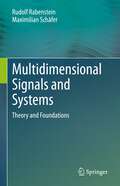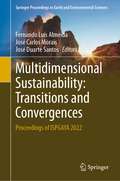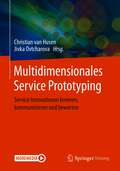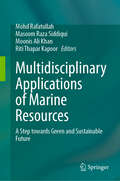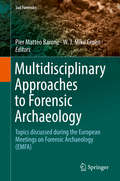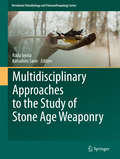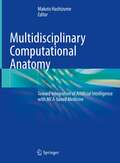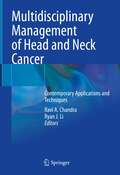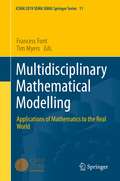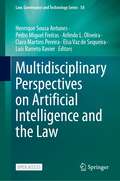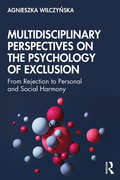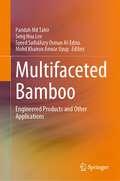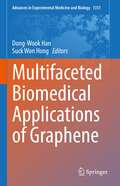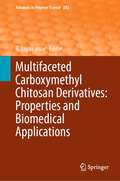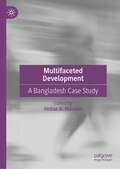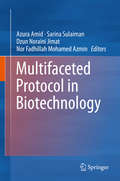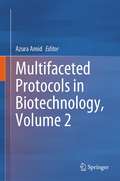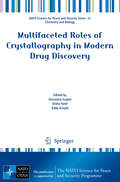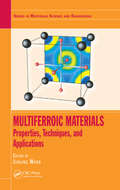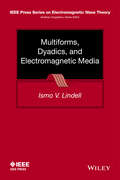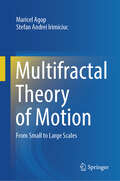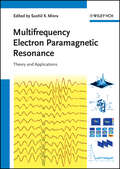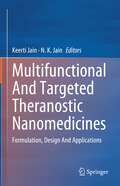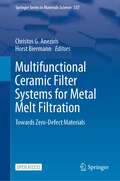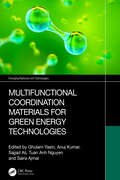- Table View
- List View
Multidimensional Signals and Systems: Theory and Foundations
by Maximilian Schäfer Rudolf RabensteinThis book covers the theory of multidimensional signals and systems and related practical aspects. It extends the properties and mathematical tools of one-dimensional signals and systems to multiple dimensions and covers relevant timeless topics including multidimensional transformations, multidimensional sampling as well as discrete multidimensional systems. A special emphasis is placed on physical systems described by partial differential equations, the construction of suitable integral transformations and the implementation of the corresponding discrete-time algorithms. To this end, signal spaces and functional transformations are introduced at a mathematical level provided by undergraduate programs in engineering and science.The presentation takes a comprehensive, illustrative and educational approach without reference to a particular application field. Instead, the book builds a solid theoretical concept of multidimensional signals and systems and shows the application to various problems relevant for practical scenarios.
Multidimensional Sustainability: Proceedings of ISPGAYA 2022 (Springer Proceedings in Earth and Environmental Sciences)
by Fernando Luís Almeida José Carlos Morais José Duarte SantosThis volume contains the proceedings of the 2022 iteration of the ISPGAYA meeting, titled “Multidimensional Sustainability: Transitions and Convergences” and held on September 29 and 30th, 2022 in Vila Nova de Gaia, Portugal. The conference and resulting book intend to explore the involvement of Portugal, a country on the semi-periphery of the world system, in developments regarding the understanding of and progress toward sustainability. The conference was organized by ISPGAYA, an institution belonging to the private polytechnic higher education system in Portugal, and brought together participants from around the world. This volume intends to establish a milestone in the multidimensional approach to the theme of sustainability, affirming the concept's multi- and interdisciplinary nature and bringing together scholars across disciplines.
Multidimensionales Service Prototyping: Service Innovationen kreieren, kommunizieren und bewerten
by Christian Van Husen Jivka OvtcharovaDas Buch stellt einen neuen Ansatz für Innovationsprozesse von Dienstleistungen vor, ein „Multidimensionales Service Prototyping“. Innovation von Dienstleistungen wird durch den Einsatz von Service Prototypen agiler und kundenorientierter. Methoden und die Umsetzung des Prototyping werden dargestellt und erläutert. In Anwendungsbeispielen werden die Entwicklung technischer Dienstleistungen von Online-Beratungsautomaten bis zu Simulatoren für die Ausbildung von Maschinenbedienern präsentiert.Prototypen sind in der Fahrzeugtechnik und im Werkzeugbau ein üblicher Entwicklungsschritt auf dem Weg zum marktreifen Produkt. Für Dienstleistungen hingegen gibt es noch kein verbindliches und wissenschaftlich erprobtes System zur Entwicklung von Prototypen. Gleichzeitig gewinnt das Angebot von Produkt-Service-Systemen als Kombination aus technischen Gütern und Dienstleistungen stark an Bedeutung. Unternehmen müssen zunehmend komplexe Dienstleistungen neu entwickeln – verbunden mit der Herausforderung, bereits im Entwicklungsprozess über Servicekonzepte zu entscheiden, diese mit den Beteiligten zu kommunizieren und zu testen. Dafür können Service Prototypen entscheidende Beiträge leisten.Videos per App: Laden Sie die Springer Nature More Media App kostenlos herunter - Abbildungen im Buch per App mit Handy oder Tablet scannen, um Videos zu streamen.
Multidisciplinary Applications of Marine Resources: A Step towards Green and Sustainable Future
by Mohd Rafatullah Riti Thapar Kapoor Masoom Raza Siddiqui Moonis Ali KhanThis book focuses on untapped marine resources for production of biofuel, biogas, bio-fertilizers, nutraceuticals, pharmaceutical and other value-added products. The applications of marine biomass and microbes in human welfare, whether individual or synergistic use, for waste management, climate change mitigation, eco-restoration, and environment protection have also been covered. This book also looks at the solutions to the problem of fossil fuel, which is one of the major sources of environmental pollution and global warming. In this context, marine-based biorefinery represents a promising approach to mitigate climate change as bio-based products are good alternatives to fossil-based fuels and synthetic chemicals due to their capacity for net-negative carbon emissions. This book is a reference material for researchers and scientists working in the field of biorefinery, pharmaceutical industry, bioremediation of contaminants and carbon neutrality for environmental safety.
Multidisciplinary Approaches to Forensic Archaeology: Topics discussed during the European Meetings on Forensic Archaeology (EMFA) (Soil Forensics)
by Pier Matteo Barone W. J. GroenThis book will present the most advanced research on forensic archaeology presented during the annual European meetings in the last 3 years. Thanks to the broad nature of the chapters presented, this book will show not only different approaches and different crime scenes around Europe, but also how every single European law enforcement has faced forensic investigations. This book shows forensic archaeology as practiced in this legal context, emerging and solidifying in many European countries, differing in some respects because of differences in legal systems but ultimately sharing common grounds. Differently from similar books, this will be not only a collection of research and case studies in which forensic practitioners demonstrate the extent and complexity of the various aspects of forensic archaeology, but also it will show the necessity of co-operation as a condition for any work in forensic archaeology among scientists of different disciplines and law enforcers.
Multidisciplinary Approaches to the Study of Stone Age Weaponry
by Radu Iovita Katsuhiro SanoThe objective of this volume is to showcase the contemporary state of research on recognizing and evaluating the performance of stone age weapons from a variety of viewpoints, including investigating their cognitive and evolutionary significance. New archaeological finds and experimental studies have helped to bring this subject back to the forefront of human origins research. In the last few years, investigations have expanded beyond examining the tools themselves to include studies of damage caused by projectile weapons on animal and hominin bones and skeletal asymmetries in ancient hominin populations. Only recently has there been a growing interest in controlled and replicative experiments. Through this book readers will be updated in the state of knowledge through a multidisciplinary scientific reconstruction of prehistoric weapon use and its implications. Contributions from expert authors are organized into three themed parts: recognizing weapon use (experimental and archaeological studies of impact traces), performance of weapon systems (factors influencing penetration depth etc. ), and behavioral and evolutionary ramifications (cognitive and ecological effects of using different weapons).
Multidisciplinary Computational Anatomy: Toward Integration of Artificial Intelligence with MCA-based Medicine
by Makoto HashizumeThis volume thoroughly describes the fundamentals of a new multidisciplinary field of study that aims to deepen our understanding of the human body by combining medical image processing, mathematical analysis, and artificial intelligence. Multidisciplinary Computational Anatomy (MCA) offers an advanced diagnosis and therapeutic navigation system to help detect or predict human health problems from the micro-level to macro-level using a four-dimensional, dynamic approach to human anatomy: space, time, function, and pathology. Applying this dynamic and “living” approach in the clinical setting will promote better planning for – and more accurate, effective, and safe implementation of – medical management. Multidisciplinary Computational Anatomy will appeal not only to clinicians but also to a wide readership in various scientific fields such as basic science, engineering, image processing, and biomedical engineering. All chapters were written by respected specialists and feature abundant color illustrations. Moreover, the findings presented here share new insights into unresolved issues in the diagnosis and treatment of disease, and into the healthy human body.
Multidisciplinary Management of Head and Neck Cancer: Contemporary Applications and Techniques
by Ravi A. Chandra Ryan J. LiThis book is a multidisciplinary guide to head and neck cancer.Head and neck cancer remains one of the most technically complex cancer subsites to manage. This field involves highly specialized, multidisciplinary management and collaboration amongst surgeons, radiation oncologists, medical oncologists, radiologists, pathologists, and other health disciplines. The clinical and research landscape for head and neck oncology continues to evolve at a rapid pace. This multidisciplinary book provides the latest updates in the contemporary understanding and management of these tumors. The text incorporates updates in surgical techniques (minimally invasive and robotic techniques, reconstructive approaches), radiation medicine (new data on dose and fields, oligometastatic/oligoprogressive disease, retreatment), medical oncology (targeted, immunotherapy and molecular agents), in addition to other overarching topics such as side effects, biomarkers/nanotechnology, and epidemiology. Written by experts in their respective fields, chapters include the most up to date scientific and clinical information with perspectives from each relevant subspeciality. These sections are concise and accessible, yet comprehensive. Palliative medicine, pathologic and imaging principles, and health systems/economics considerations are also described. This book is an ideal resource for clinicians, trainees, and researchers dealing with, and interested in, this challenging malignancy.
Multidisciplinary Mathematical Modelling: Applications of Mathematics to the Real World (SEMA SIMAI Springer Series #11)
by Francesc Font Tim G. MyersThis book presents a selection of the talks resulting from research carried out by different groups at the Centre de Recerca Matemàtica and presented at the International Congress on Industrial and Applied Mathematics, held in Valencia in 2019. The various chapters describe a wide variety of topics: cancer modelling, carbon capture by adsorption, nanoscale diffusion and complex systems to predict earthquakes. These mathematical studies were specifically aided via collaborations with biomedical engineers, physicists and chemists. The book is addressed to researchers in all of these areas as well as in general mathematical modelling.
Multidisciplinary Perspectives on Artificial Intelligence and the Law (Law, Governance and Technology Series #58)
by Arlindo L. Oliveira Henrique Sousa Antunes Pedro Miguel Freitas Clara Martins Pereira Elsa Vaz de Sequeira Luís Barreto XavierThis open access book presents an interdisciplinary, multi-authored, edited collection of chapters on Artificial Intelligence (‘AI’) and the Law. AI technology has come to play a central role in the modern data economy. Through a combination of increased computing power, the growing availability of data and the advancement of algorithms, AI has now become an umbrella term for some of the most transformational technological breakthroughs of this age. The importance of AI stems from both the opportunities that it offers and the challenges that it entails. While AI applications hold the promise of economic growth and efficiency gains, they also create significant risks and uncertainty. The potential and perils of AI have thus come to dominate modern discussions of technology and ethics – and although AI was initially allowed to largely develop without guidelines or rules, few would deny that the law is set to play a fundamental role in shaping the future of AI.As the debate over AI is far from over, the need for rigorous analysis has never been greater. This book thus brings together contributors from different fields and backgrounds to explore how the law might provide answers to some of the most pressing questions raised by AI. An outcome of the Católica Research Centre for the Future of Law and its interdisciplinary working group on Law and Artificial Intelligence, it includes contributions by leading scholars in the fields of technology, ethics and the law.
Multidisciplinary Perspectives on the Psychology of Exclusion: From rejection to personal and social harmony
by Agnieszka WilczyńskaThis new volume considers one of the most pressing topics of the generation: the sense of social exclusion, rejection and loneliness experienced by many adolescents and young adults. It offers insights from psychological and biochemical research, explaining the role of the brain, mind and body in the development of a sense of belonging over the lifespan. Illustrated with examples of the consequences of exclusion drawn from the author’s clinical work, this important work surveys the latest research in the field and introduces an innovative framework for understanding the development of a sense of belonging. Wilczyńska considers the effects of social exclusion, exploring its consequences for mental health, particularly amongst young people, and reveals how transgenerational trauma imprinted at the early stages of human development impacts lifelong development. Including a foreword by Philip Zimbardo, Multidisciplinary Perspectives on the Psychology of Exclusion is essential reading for students and researchers of developmental psychology, social psychology and sociology. It will also be of interest to practitioners and policymakers working with children and young people to understand and mitigate the effects of social exclusion and loneliness.
Multifaceted Bamboo: Engineered Products and Other Applications
by Paridah Md Tahir Seng Hua Lee Syeed SaifulAzry Osman Al-Edrus Mohd Khairun Anwar UyupThis book highlights the basic properties of round bamboo and bamboo strips of various species worldwide. Processing and properties enhancing treatment of bamboo strips and round bamboo are discussed. It presents the structural applications of round and engineered bamboo and provides an insight on the potential applications as construction and building materials. Bamboo as multipurpose plant in various fields such as chemical feedstocks, energy sources, furniture, fabric, pulp and paper, and their recent developments are also discussed in detail. The book also includes the economic, social, and environmental assessment of bamboo products.
Multifaceted Biomedical Applications of Graphene (Advances in Experimental Medicine and Biology #1351)
by Dong-Wook Han Suck Won HongThis book explains the fundamental characteristics and biofunctionality of graphene-based nanomaterials and provides up-to-date information on the full range of their biomedical applications. An introductory section gives an overview of the chemical composition and physical properties of graphene and its derivatives as well as their potential toxicity and biosafety. Detailed attention is then devoted to the potential of multifunctional graphene-based nanomaterials (MFGNs) to direct the differentiation of stem cells into specific lineages and induce tissue regeneration. Here, individual chapters address the application of MFGNs for the purposes of neurogenesis, osteo- and chrondrogenesis, myogenesis, and wound healing. Subsequent sections focus on the capability of MFGNs as agents for drug delivery, bioimaging, theranostics, and therapeutics as well as their effectiveness as biomimetic platforms for nanobiosensors, biochips, medical devices, and dental applications. The book will be essential reading for graduate students, scientists, and engineers in any of the biomedical research fields in which efforts are being made to utilize novel MFGN-incorporated composite materials and develop functional devices based on them.
Multifaceted Carboxymethyl Chitosan Derivatives: Properties and Biomedical Applications (Advances in Polymer Science #292)
by R. JayakumarThis edited collection deals with the structure-property relationships and biomedical applications of carboxymethyl chitosan derivatives in different fields. Readers will detailed overview of the preparatory methods involved in the derivatives of carboxymethyl chitosan and its interaction with metal ions. The chapters provide a detailed overview of the different types of carboxymethyl chitosan derivatives, including the preparatory methods involved, the interactions with metal ions, and the antimicrobial activities. These different forms of carboxymethyl chitosan derivatives are found to be potentially used in food packaging, in enhancing saltiness, as biosensors, and also as wound dressing. Chapters are also devoted to the fabrication and biomedical applications of carboxymethyl chitosan derivatives-based nanofibers as well as the interaction of carboxymethyl chitosan with blood in blood clotting and the underlying mechanism. Contributing authors additionally explore topics related to carboxymethyl chitosan-based hydrogels, films, scaffolds, fibers, and composites. Finally, this volume presents the current challenges in developing biomedical products based on carboxymethyl chitosan derivatives. This book will be of interest not only to chemists, but to all scientists working in the fields of material/environmental science, biological science, and biomaterials. These chapters are great resources for any researcher who works with structure-property relationships, biological interactions, and the applications of carboxymethyl chitosan derivatives in different biomedical fields.
Multifaceted Development: A Bangladesh Case Study
by Imtiaz A. HussainThis book focuses on the modernization of Bangladesh. It does so by including case studies at the national and sub-national government levels and comparative studies with other countries.Chapters in the book highlight how a number of aspects have been affected in the modernization process, such as the adoption of ‘western’ curriculum and English language in schools, the use of animation to boost school student comprehension of texts, the rural–urban divide, pedagogical training to emergent andragogy-dependent market needs, converting ‘local ’ shipping experiences to fill growing ‘global ’ needs, and multilateral environmental adaptation and mitigation mandates being adopted ‘locally.’
Multifaceted Protocol in Biotechnology
by Azura Amid Sarina Sulaiman Dzun Noraini Jimat Nor Fadhillah AzminThis edited work presents useful methods in experimenting in the area of Bioprocessing and Biotechnology. The four sections cover the area of Bioprocess, Whole Cells & Isolated Biocatalyst, Characterization of Biochemical Products and Cell Isolation & Culture. Its enable researchers to choose a suitable method and plan their experiments in details. The main focus of this book is to provide step by step method to young researchers, especially in the new research areas. Among the latest areas are the isolation of novel strain or enzyme by metagenomic approaches and taming procedure in the laboratories, development of novel, the cheap and non-toxic catalyst for biodiesel production, and production of micro-fibrillated cellulose. An updated method for well-known areas such as immobilization technology, biosensor, and polymerization was also presented. The book also covers in-silico methods such as MATLAB platform to ease researchers. Not to forget, the method in animal and plant culture is also discussed in detail.The book is written by chapter authors with much expertise in their fields. They have published multiple articles in the index listed journals.The topic of this book is particularly relevant to young researchers who are struggling to fine-tune their research and do not want to waste their time in optimizing the experiment set up.
Multifaceted Protocols in Biotechnology, Volume 2
by Azura AmidThis contributed volume, “Multifaceted Protocols in Biotechnology, Volume 2”, consists of multidisciplinary methods and techniques commonly used in biotechnology studies. There are two sections covered in this book – Ionic Liquid Related Techniques & Evergreen Biotechnology Techniques. A brief introduction supports each protocol to allow easy learning and implementation. The first section consists of three chapters covering studies in modern biotechnology focusing on the role of ionic liquid techniques in extracting secondary metabolites, enzyme stabilization and biomass processing. The second section covers evergreen methodologies. It comprises five chapters covering topics on microcarrier technology for cell culture; Polymerase Chain Reaction for non-halal sources detection in food; ELISA for biomarker identification; gamma ray-induced mutagenesis for enhancing microbial fuel cells; and the effect of temperature on antibacterial activity of Carica papaya seed extract. This book will be useful to graduate students, researchers, academics, and industry practitioners working in the area of biotechnology
Multifaceted Roles of Crystallography in Modern Drug Discovery
by Giovanna Scapin Disha Patel Eddy ArnoldThe present work offers a snapshot of the state-of-the-art of crystallographic, analytical, and computational methods used in modern drug design and development. Topics discussed include: drug design against complex systems (membrane proteins, cell surface receptors, epigenetic targets, and ribosomes); modulation of protein-protein interactions; the impact of small molecule structures in drug discovery and the application of concepts such as molecular geometry, conformation, and flexibility to drug design; methodologies for understanding and characterizing protein states and protein-ligand interactions during the drug design process; and monoclonal antibody therapies. These methods are illustrated through their application to problems of medical and biological significance, such as viral and bacterial infections, diabetes, autoimmune disease, and CNS diseases. As approaches to drug discovery have changed over time, so have the methodologies used to solve the varied, new, and difficult problems encountered in drug discovery. In recent years we have seen great progress in the fields of genetics, biology, chemistry, and medicine, but there are still many unmet medical needs, from bacterial infections to cancer to chronic maladies, that require novel, different, or better therapies. This work will be of interest to researchers and policy makers interested in the latest developments in drug design.
Multiferroic Materials: Properties, Techniques, and Applications (Series in Materials Science and Engineering)
by Junling Wang"a very detailed book on multiferroics that will be useful for PhD students and researchers interested in this emerging field of materials science" —Dr. Wilfrid Prellier, Research Director, CNRS, Caen, France Multiferroics has emerged as one of the hottest topics in solid state physics in this millennium. The coexistence of multiple ferroic/antiferroic properties makes them useful both for fundamental studies and practical applications such as revolutionary new memory technologies and next-generation spintronics devices. This book provides an historical introduction to the field, followed by a summary of recent progress in single-phase multiferroics (type-I and type-II), multiferroic composites (bulk and nano composites), and emerging areas such as domain walls and vortices. Each chapter addresses potential technological implications. There is also a section dedicated to theoretical approaches, both phenomenological and first-principles calculations.
Multiforms, Dyadics, and Electromagnetic Media
by Ismo V. LindellThis book applies the four-dimensional formalism with an extended toolbox of operation rules, allowing readers to define more general classes of electromagnetic media and to analyze EM waves that can exist in them End-of-chapter exercises Formalism allows readers to find novel classes of media Covers various properties of electromagnetic media in terms of which they can be set in different classes
Multifractal Theory of Motion: From Small to Large Scales
by Maricel Agop Stefan Andrei IrimiciucThis book aims to present the topic of nonlinear and chaotic dynamics in a manner that is useful and beneficial to students and young researchers from various domains such as physics, mathematics, biology, or even medicine. A very important aspect of that topic is that the constraints of determinism do not imply a regular behavior or do not rely on predictability in describing the dynamics of natural systems. Exploring the evolution of natural systems has a great impact nowadays on a wide range of scientific domains. The dynamics of populations, cardiac fibrillation, communication systems, fluid flow, and atmospheric systems are just a few topics in which nonlinearity and chaos are a regular manifestation. This leads to the idea that it is necessary to find universal laws that govern these dynamics. The aforementioned variety in scientific topics is also sustained by an exponential interest in recent decades from readers in the scientific community and the non-scientific one as well. The book is devoted to the nonlinear and chaotic dynamics topic, a domain that is both trans- and multi-disciplinary and has been the focus of the scientific community in past decades.
Multifrequency Electron Paramagnetic Resonance: Theory and Applications
by Sushil K. MisraFilling the gap for a systematic, authoritative, and up-to-date review of this cutting-edge technique, this book covers both low and high frequency EPR, emphasizing the importance of adopting the multifrequency approach to study paramagnetic systems in full detail by using the EPR method. In so doing, it discusses not only the underlying theory and applications, but also all recent advances -- with a final section devoted to future perspectives.
Multifunctional And Targeted Theranostic Nanomedicines: Formulation, Design And Applications
by N. K. Jain Keerti JainThis book discusses approaches based on multifunctional and targeted theranostic nanomedicines for improving diagnosis and drug delivery. It explores nanomedicines based on nanocarriers like liposomes, ethosomes, niosomes, polymeric nanoparticles, lipidic nanoparticles, metallic nanoparticles, micelles, dendrimers, quantum dots, carbon-based nanomaterials including carbon nanotubes, carbon dots, carbon quantum dots, graphene oxide, and fullerene. This book reviews designing, conjugation, optimization, formulation and development, and scale-up of multifunctional and targeted theranostic nanomedicines. It examines major challenges in developing nanomaterials that can be applied to nanomedicine with high biocompatibility and biodegradability for diagnostic and therapeutic purposes. Lastly, it addresses the most promising approaches at both commercialization and regulatory steps for bringing theranostic nanomedicine from research laboratories to clinics for patient use.
Multifunctional Ceramic Filter Systems for Metal Melt Filtration: Towards Zero-Defect Materials (Springer Series in Materials Science #337)
by Horst Biermann Christos G. AnezirisThis open access book covers novel techniques and materials for removing inclusions in metallic melts, resulting in significant improvements to the purity, quality, and materials properties of the cast metal product. It looks at an entirely new generation of intelligent filter materials and filter systems with functionalized surfaces for removing solid and liquid inclusions such as deoxidation products, sulfides, and nitrides carbide from metallic melts. This collection of contributed chapters addresses the overarching goal of the production of lightweight structures and high-demand construction materials within an overall substantially cleaner and more sustainable global supply chain. The chapters cover a diverse array of topics ranging in scope from the development of ceramic foam filters, to in-situ x-ray and optical characterization techniques, as well as advanced modelling of 3D-printed filter structures. Additionally, the book features a number of contributions directly transferable to industrial applications related to the clean metal casting technologies of aluminium and steel alloys.
Multifunctional Coordination Materials for Green Energy Technologies (Emerging Materials and Technologies)
by Anuj Kumar Tuan Anh Nguyen Ghulam Yasin Sajjad Ali Saira AjmalAs an emerging material platform, multifunctional coordination materials offer many advantages such as remarkable porosity, structural flexibility, crystallinity, and modifiable functionalities that render them highly suited to generate and store green energy. This book covers the design and fabrication approaches of multifunctional coordination materials for green energy-related technologies, including batteries, supercapacitors, solar cells, and nanogenerators. Discusses fundamentals of multifunctional coordination materials Explains vital synthesis and design techniques as well as theoretical modeling Offers a comprehensive overview of preparation, structural and morphological properties, and applications in a wide variety of energy production, energy storage, and energy device technologies Assesses environmental impacts, recycling, challenges, and future perspectives Multifunctional Coordination Materials for Green Energy Technologies is an ideal reference for advanced students and researchers working in materials engineering, including new catalyst development, battery design, and related areas.
